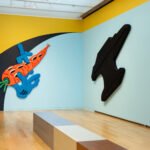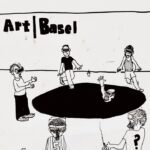On Monday, a representative for Curtis Yarvin sent over a video that served as a preview for the influential monarchist and coder’s desired curation of the US pavilion at the 2026 Venice Biennale. In the clip, a computer-animated Donald Trump stands on the Rialto Bridge as protesters holding “Curtis Yarvin Is the Devil” signs gather below. When digital Yarvin sends in a wave to wash away the protesters, with laser beams shooting from his eyes, they are converted to the “dark enlightenment art world.”
As the images roll over the screen, there’s a voice-over from Yarvin, who’s labeled as the “dark lord of the tech right.”
“I just talked to the undersecretary of public diplomacy and public affairs,” Yarvin says in the video, with text on State Department letterhead appearing on the screen. “We are gonna Trumpify the Venice Biennale this year. To give that world control at the Venice Biennale would be the absolutely most fucked-up maneuver ever. We’re going to go in and reconstruct the American arts with one violent executive order and take over the whole fucking thing.”
At the end, viewers see the US pavilion done up in Trumpian gold and black, à la Trump Tower. Instead of the current text above the entrance, “STATI UNITI D’AMERICA,” the text reads: “SALON DES DEPLORABLES.”
On Tuesday, Yarvin—whose radical ideas of politics and government have been taken up, to varying degrees, by the likes of JD Vance, Peter Thiel, and Marc Andreessen—was ready to reveal to me the details of his pavilion. He admitted that it is, for now, still a proposal. As I reported in May, the portal for applicants is open to all and will be accessible until July 30, but Yarvin sees a lane for himself and his collaborators. In his estimation, detailed in a memo titled “Instructions for a coup,” the applicant field has thinned since my reporting revealed that the grant documents were edited to remove references to DEI. He is betting that museums would rather boycott than take up the most prestigious perch in American exhibitions. “A vacuum has opened,” he wrote.
Two weeks ago a lengthy profile of Yarvin in The New Yorker hinted at the proposal, and reported that he had been speaking about it with Darren Beattie, the acting State Department undersecretary whom Yarvin referenced in the video. The New Yorker reported that the proposal had something to do with “dissident-right art hos.”
When we connected on Tuesday, I asked him to clarify.
“A dissident-right art ho is—first of all, you have to understand what an art ho is,” he said. “It’s sort of obvious…. To get very, very technical and psychological about it, what I would say is that—are you familiar with Maslow’s pyramid of needs?”
I wasn’t. Yarvin went on to explain it in depth—technically, 20th century psychologist Abraham Maslow called his theory on human motivation a “hierarchy” rather than a “pyramid”—before explaining that “art ho” wasn’t even necessarily gendered.
“In a way, Donald Trump himself is kind of an art ho, because he basically—first of all, he has very small, feminine hands,” Yarvin said. “But he also operates largely on the basis of a woman. Like a woman, he operates largely on the basis of intuition. He’s a very intuitive thinker.”
It was Tuesday evening in Switzerland, and Yarvin had just arrived in Basel on the day that the Art Basel fair opened to First Choice VIPs. During our hour-long video chat, as he drank a few glasses of red wine, he explained to me his concept for the pavilion in a monologue peppered with lengthy digressions—Anora is a “hardcore right-wing film,” Silicon Valley billionaires should support the fine arts, Trump and Vance are actually conceptual artists themselves—and sweeping takes on how to both interact with and subvert the elite systems that govern culture.
But above all, he acknowledged that, as someone very much outside the institutional art world establishment, he was not your typical curator of art. Why, then, had he traveled to one of its most sacred sites, Art Basel in Switzerland, and rented a flat a few minutes from the Messeplatz to host a party where he would announce his pavilion proposal in a city swimming with elite Brahmins?
“The purpose is to freak people out,” he said. “The barbarians are at the gates, right?”
“What if we do a Thomas Kinkade retrospective?” he wondered at one point during our chat. “You could do that. And it would be funny as an art prank, but I think it would get old.”
His proposal is decidedly not a Thomas Kinkade retrospective. Instead, Yarvin teamed up with the Dutch Egyptian artist Tarik Sadouma—making him an atypical choice for the American pavilion. (Yarvin acknowledged the approach was unorthodox, shrugging and offering, “We’re going to say that it’s actually my idea, because I’m an American.”)
Sadouma has a collective, The Unsafe House, based in Amsterdam. Along with Yarvin, it would curate a group show that would take as its starting point Titian’s painting The Rape of Europa, a depiction of the Tyrrhenian princess getting abducted by the Greek god Zeus. It’s currently hanging in the Isabella Stewart Gardner Museum in Boston, but Titian, one of the greatest artists in the history of La Serenissima, initially painted it in Venice between 1559 and 1562.




No Comment! Be the first one.